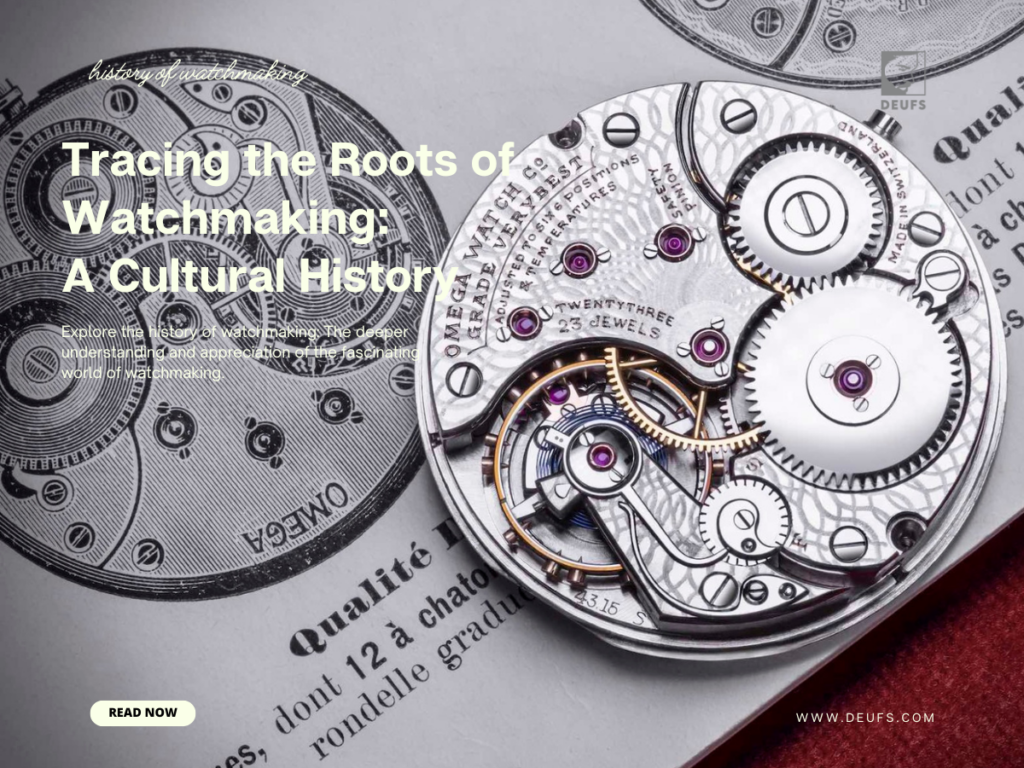
Introduction
As someone who has always been fascinated by the art and science of watchmaking, I have spent years exploring the rich history of this incredible industry. From the early days of clockmaking to the modern world of smartwatches, the history of watchmaking is a fascinating journey through time, culture, and innovation.
From the skilled artisans of Switzerland to the innovative designers of Japan, watchmaking is a global industry that has touched every corner of the world. In this blog post, I will take you on a journey through the history of watchmaking, exploring the rich traditions and cutting-edge innovations that have shaped this incredible industry. Whether you are a watch enthusiast, a historian, or someone who loves a good story, this post will give you a deeper understanding and appreciation of the fascinating world of watchmaking.
Tracing the Roots: The Early History of Watchmaking
The art of watchmaking has evolved significantly since its humble beginnings as a tool for keeping track of time. In fact, the roots of watchmaking can be traced back to the early days of clockmaking, when timepieces were first created to help people keep track of the passage of the day. These early clocks were often quite large and cumbersome, with heavy weights and intricate gear systems that were powered by the movement of a person’s hand.
As time went on, clockmakers began to develop smaller, more portable timepieces that could be carried by a person. These “pocket watches” were much more convenient than their larger counterparts and allowed people to keep track of the time while on the go. However, pocket watches were still relatively bulky and difficult to carry. It was in the development of wristwatches that the true potential of portable timekeeping was realized.
The first wristwatches were created in the late 19th century and were primarily worn by military personnel and women. They were initially seen as a novelty and were not particularly popular. However, as the technology behind wristwatches improved, they became more reliable and accurate and began to gain widespread acceptance.
Today, watchmaking has evolved into a highly specialized field, with skilled craftsmen and women creating intricate timepieces using a wide range of materials and techniques. From pocket watches to wristwatches and from mechanical to quartz, the history of watchmaking is a rich and fascinating one that continues to evolve even to this day.
Swiss Watchmaking: How a Small Country Became a Giant
(Image of Swiss Watchmaking)

Swiss watchmaking is a true marvel of the modern world, with a rich history that dates back centuries. It is a testament to the Swiss people’s dedication, skill, and innovation that a small country like Switzerland has become the global leader in producing high-quality timepieces.
In the industry’s early days, Swiss watchmakers were renowned for their exceptional craftsmanship and attention to detail. They were masters of their trade, creating timepieces that were not only accurate but also aesthetically pleasing. As demand for their products grew, Swiss watchmakers established themselves as the premier producers of fine watches. Their reputation for quality and reliability only continued to grow.
Today, Swiss watchmaking remains a world-renowned industry, with brands like Rolex, Patek Philippe, and Omega known for their exceptional craftsmanship and attention to detail. These brands are synonymous with luxury and quality and are coveted by collectors and enthusiasts worldwide.
But Swiss watchmaking is not just about producing beautiful, luxurious timepieces. It is also about innovation and continuous improvement. Swiss watchmakers constantly push the boundaries of what is possible, developing new technologies and materials to create more accurate and reliable timepieces.
In short, Swiss watchmaking is a true testament to the Swiss people’s talent, skill, and dedication, and it is no wonder that this small country has become a giant in the world of fine timepieces.
Watchmaking in Japan: From Traditional Craftsmanship to Modern Innovation
Watchmaking in Japan has a long and rich history that dates back to the early 20th century when Japanese watchmakers began to develop their own distinct style by combining traditional craftsmanship with modern technology. From the very beginning, Japanese watchmakers were known for their attention to detail and commitment to producing high-quality timepieces.
One of the key factors that have contributed to the success of Japanese watchmaking is the country’s focus on innovation and continuous improvement. Japanese watchmakers have always been at the forefront of developing new technologies and materials and have quickly adopted new techniques and methods as they have become available. This focus on innovation has allowed Japanese watchmakers to produce some of the world’s most advanced and reliable timepieces.
Today, Japanese brands like Seiko and Citizen are known for their innovative designs and advanced technology, making them some of the most sought-after timepieces in the world. In addition to their technical prowess, these brands are known for their attention to detail and commitment to producing high-quality watches built to last.
In conclusion, watchmaking in Japan is a testament to the country’s long tradition of craftsmanship, innovation, and dedication to quality. It is no wonder that Japanese brands are some of the most respected and sought-after in watchmaking.
Watchmaking in American History: From Pocket Watches to Smartwatches
Watchmaking has a rich and storied history in the United States, dating back to the early days of the nation’s founding. Early American watchmakers were known for their exceptional craftsmanship and attention to detail, creating timepieces that were not only accurate but also aesthetically pleasing.
One of the earliest and most influential American watchmakers was Eli Terry, credited with revolutionizing the industry with his innovative mass-production techniques. Terry’s system allowed for more affordable and accessible timepieces, leading to a proliferation of pocket watches in the early 19th century.
Another notable figure in American watchmaking was Aaron Dennison, who founded the Waltham Watch Company in the 1850s. Dennison’s company was known for its precision machinery and interchangeable parts, which allowed for the efficient and consistent production of high-quality timepieces.
As the industry continued to evolve, American brands like Timex and Fossil emerged as leaders in the field, known for their modern designs and advanced technology. Today, American watchmaking continues to thrive, with companies like Citizen and Seiko also making a mark on the global market.
Despite technological advancements and the proliferation of smartwatches, traditional watchmaking techniques and craftsmanship remain an important part of the American watchmaking tradition. Many contemporary brands continue to pay homage to the rich history of American watchmaking, incorporating elements of traditional design and techniques into their modern timepieces.
Watchmaking in Other Countries: From France to Germany and Beyond
Watchmaking has a global history, with many countries contributing to the development and evolution of the industry. In France, for example, watchmaking has a long and storied tradition dating back to the 16th century. French watchmakers were known for their exceptional craftsmanship and attention to detail, creating timepieces that were not only accurate but also aesthetically pleasing.
One of the most well-known French watch brands is Cartier, founded in 1847 by Louis-François Cartier. Cartier is known for its luxury timepieces, often adorned with precious gems and intricate designs. Another notable French brand is Breguet, founded by Abraham-Louis Breguet in 1775. Breguet is known for its innovative designs and use of advanced technology, such as the first self-winding watch and the first wristwatch.
Germany is also home to a thriving watchmaking industry, with brands like A. Lange & Söhne and Glashütte Original known for their precision engineering and innovative designs. A. Lange & Söhne was founded in 1845 by Ferdinand Adolph Lange. It is known for its high-quality timepieces with intricate detailing and craftsmanship.
Glashütte Original, founded in 1845, is known for its use of advanced technology and innovative design, such as its patented large date indicator and stop-seconds mechanism. The global history of watchmaking is a testament to the enduring appeal and enduring craftsmanship of timepieces.
Watchmaking in England, China, India, and Russia
England has a long and rich history in watchmaking, with many well-known brands having their roots in the country. Some of the most notable English watch brands include Rolex, Omega, and Breitling, all known for their exceptional craftsmanship and attention to detail. English watchmakers have a reputation for creating timepieces that are both accurate and aesthetically pleasing, and many English timepieces are highly valued by collectors.
In contrast, the history of watchmaking in China is relatively recent. Still, the country has quickly become a major player in the industry. Chinese watchmaking is known for its focus on affordability and accessibility, with many Chinese brands offering high-quality timepieces at prices that are easy to afford. Despite the rise of inexpensive, mass-produced watches, Chinese watchmaking also has a tradition of producing high-end, handcrafted timepieces using traditional techniques.
India also has a long and rich history in watchmaking, with many of the country’s finest timepieces handcrafted by skilled artisans. Indian watchmaking is known for its focus on traditional techniques and craftsmanship, with many Indian brands still using the same methods passed down through the generations. Indian watchmakers are known for paying close attention to the smallest details and being able to make complicated and beautiful timepieces.
Russia also has a rich history in watchmaking, with many of the country’s finest timepieces being created by skilled craftsmen in watchmaking workshops. Russian watchmaking is known for its focus on durability and dependability. Many Russian watches are still highly valued for their ability to withstand rough conditions. Russian watchmakers are known for paying close attention to details and using old-fashioned methods. This helps them make timepieces that work well and look good.
The Future of Watchmaking: How the Industry is Evolving in the Modern World
The history of watchmaking is not just a story of the past but also a glimpse into the industry’s future. With smartwatches and other new technologies becoming more popular, the watchmaking industry is always changing, and the future looks good. As technology improves, the world of watchmaking will continue to change and grow, creating new and exciting timepieces that will keep us interested for years to come.
Ultimately, the history of making watches is an interesting trip through time, culture, and new ideas. From when people made clocks to the present day, when people wear smartwatches, watchmaking has changed and grown with the times and technologies. As we look to the industry’s future, we can be sure that watchmaking will continue to be a vibrant and exciting field, full of incredible stories, beautiful timepieces, and endless possibilities.






